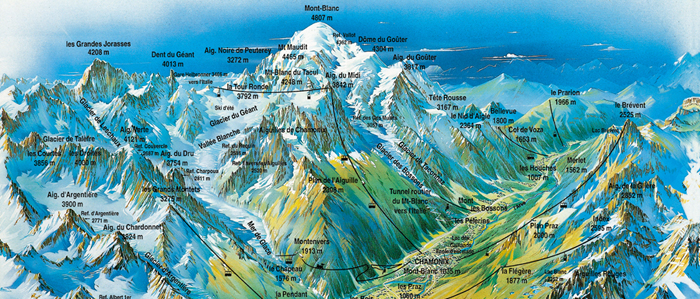WELCOME TO CHAMONIX MONT-BLANC
Chamonix offers exceptional viewpoints, which can be reached either by use of the lifts or the hiking trails. The different panoramas are situated along the length and breadth of the valley, in the heart of the Mont-Blanc and Aiguilles Rouges mountain ranges. An extraordinary panoramic trip, accessible to all. Just a few minutes cable travel or a few hours on foot for the hardy and you will find yourselves immersed in the beauty of this majestic site.
Mont Blanc
The “roof of Europe”, the world’s third-ranking most visited natural area, continues to attract millions of visitors and thousands of mountaineers every year. Conquering Mont Blanc is a dream shared by many amateur mountaineers and enthusiasts. This dream is possible as long as one does not underestimate the apparently easy slopes of this legendary mountain.
The last measurements of mont Blanc: September 2009
New measurements of mont Blanc’s altitude: 4810.45 m, unfailing stability!
According to the measurements taken in September 2007, mont Blanc, the highest peak in the Alps and Western Europe, had an altitude of 4810.90 metres, i.e., an increase of 2.15 metres in relation to 2005 – a record altitude since the first GPS measurements in 2001. On 12 & 13 September 2009, Haute-Savoie’s land surveyors performed the 5th operation for measuring the altitude of the roof of Europe, as part of Annecy’s candidature for the 2018 Winter Olympics.
According to the first analyses performed, Mont Blanc measures exactly 4,810.45 m, and the volume of ice above 4,800 m is 21,626 m3. Due to the prevailing winds, the summit has moved 26m to the East (following the axis of the top ridge), towards Italy.
Glaciers in the Chamonix Valley
Covering a surface area of 125 km2, the glaciers are omnipresent in the Chamonix valley and contribute to the outstanding beauty of the site. Since time memorial, these ice giants have inspired fear, incredulity and admiration.
The Bossons glacier
As one arrives in the Chamonix valley, one cannot help being overwhelmed by the Bossons and Mont-Blanc glacier « largest ice fall in Europe » ! The glacier has a long history and it was on it's flanks that man chose to excavate the first ice grotto in 1870. Due to its steep incline, it is the fastest moving glacier (300m/year) and it also reacts most rapidly to climate change. The passionate history of the glacier is related in an outdoor exhibition located close to the Chalet du Chalet du Glacier des Bossons. Nine illustrated information panels present different aspects of the glacier: its life, evolution of a glacier, the small ice age... The exhibition is translated into English and German and is free of charge. The Chalet du Glacier des Bossons is open from June to September.
The Mer de Glace
« A sea, stirred by a strong breeze, then suddenly frozen to ice » Windham (1741)
The Mer de Glace is one of the worlds most visited natural sites. This enthusiasm began in the 18th century when wealthy and learned travellers, in quest of discovery and knowledge, began to show an interest in the glaciers and in particular this unique spot. Since 1908 the Montenvers-Mer de Glace cog railway enables enthusiastic visitors to follow in the footsteps of those illustrious pioneers: Rousseau, Hugo, Nodier, Sand, Goethe, Shelley, Liszt and so many more...
The ice grotto: takes you into the heart of the glacier where you may discover the astounding colour of the ice, beautiful carvings and models in period clothing, witness to bygone mountain life, as if frozen in time. Every year (and for the past 50 years) a new grotto is meticulously sculpted in the ice as the previous work of art is slowly but surely transported down the valley by the glacier.

 I-Geneva
I-Geneva Flight info
Flight info I-Chamonix
I-Chamonix Informations Chamonix ski
Informations Chamonix ski Chamonix map
Chamonix map Weather forecast
Weather forecast Info
Info Vehicle
Vehicle Links
Links Terms and Conditions
Terms and Conditions FR
FR EN
EN ES
ES

